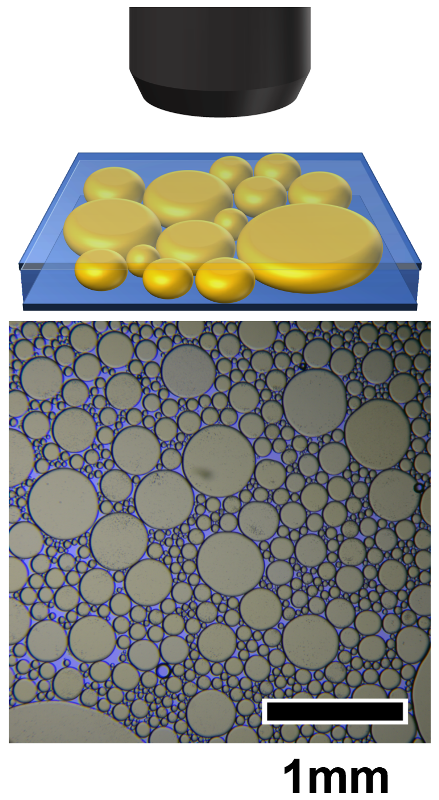It is widely known how various mechanical processes affect the behavior of particles, such as sand or liquid droplets. Understanding this can be helpful in a variety of sectors because congestion frequently happens in circumstances when space is limited.

Polydisperse particles. Schematic of the experimental setup and microscopic image of polydisperse oil droplets confined in two-dimensional space. Image Credit: 2023 Yanagisawa and Shimamoto
However, only situations where the concerned particles are identical or have a limited size range have been satisfactorily modeled. For the first time, a model has been developed to characterize particle bodies in a variety of jamming situations and sizes.
When several balls are crammed into a box, especially if they are all the same size, the amount of empty space between them can be seen. Due to the presence of smaller balls that can fill the spaces between larger ones, the more diverse the sizes of the balls, however, the more of that empty space can be filled.
This issue seems intuitively simple, but as is frequently the case with such things, modeling how it actually occurs is quite challenging. Additionally, it is difficult to predict how packed items or particles will behave in a certain physical situation the less regular they are.
For the first time, scientists from the University of Tokyo’s Komaba Institute for Science have discovered a structure that frequently manifests when particles with severe size variation are randomly packed together, independent of their size distribution.
People whose jobs require the transportation, separation, or mixing of particulate matter could find this type of model to be of considerable help. For instance, the construction industry employs materials like stones, sand, and cement; the medical field uses biomolecules, powders, and oil droplets; food manufacturers package grains, seeds, and fruits; and so on.
When I thought about what might be happening inside a packed collection of mixed particles, it made me want to explore this experimentally. One of the challenges to doing this, though, lies in how to make an idealized sample of packing particles.
Miho Yanagisawa, Associate Professor, Graduate School of Arts and Sciences, University of Tokyo
Yanagisawa added, “In our experiment, droplets of oil in water were repeatedly fractured to break them up in an ordered way. This yielded particle sizes which followed a mathematical pattern called a power distribution. Essentially a very broad range of sizes, this was important so that no one size range would be overrepresented in our results. The droplets were gently compressed between two glass plates; this constrained them to a two-dimensional surface and prevented them from overlapping vertically, which was critical for our imaging analysis.”
In two dimensions, identical particles will arrange themselves as a hexagonal lattice. But this structural symmetry is disrupted if size fluctuates or if they are considered to be polydisperse.
However, Yanagisawa and colleague Daisuke Shimamoto discovered that although it is not immediately apparent, randomly packed particles with extreme size diversity really have a similar structure. This statistical model, as opposed to the geometric model, shows how different-sized particles are distributed when they clash.
As a result, it is possible to predict the ideal particle size variation circumstances that enable tighter packing, which might result in less unused space in situations where spatial efficiency is crucial.
Yanagisawa concluded, “Although diversity and universality seem to be contradictory concepts, this study shows diversity can produce universality. In fact, diverse size distributions are common in nature. Therefore, even phenomena that appear to be very diverse at first look may have a hidden universality, or universality can be revealed by considering the particle distribution of the system as a whole.”
Journal Reference
Shimamoto, D., et al. (2023) Common packing patterns for jammed particles of different power size distributions. Physical Review Research. doi:10.1103/PhysRevResearch.5.L012014.